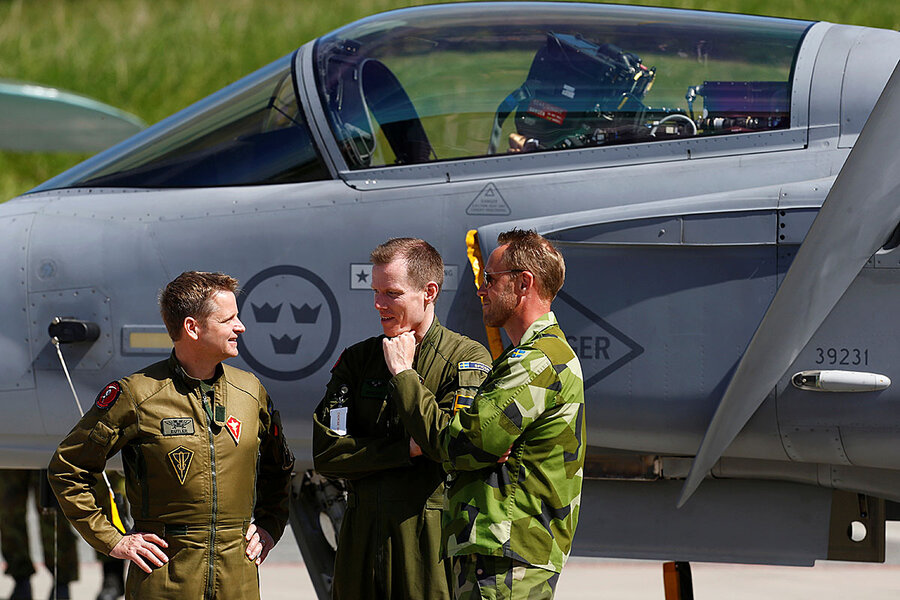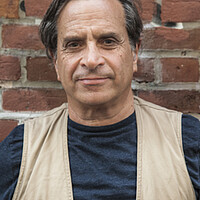In Sweden, conscription and a leaflet on how to prepare for war – just in case
Loading...
| Stockholm
Last May, the Swedish government issued a pamphlet to all 4.8 million Swedish households illuminating the dangers of war, including – implicitly – war with Russia. The booklet, titled “If Crisis of War Comes,” instructed the population on what to do “if their everyday [lives] were turned upside down.” It was the latest step the government has taken to get the country up to speed militarily, following Russia’s annexing of Crimea in 2014. This year 4,000 men and women became the first draftees in Sweden since conscription ended in 2010. But as Sweden waits to see what kind of government emerges from September’s inconclusive parliamentary election, some say that it still is not doing enough. Polling suggests that Sweden’s attitude toward defense is split among the generations, with those under 25 less concerned about war, while middle-aged and older Swedes are more anxious. In Parliament, both NATO membership and increased military spending have been on and off the table. “Swedish neutrality dies hard,” says Robert Dalsjö at FOI, a Swedish defense think tank. It is “sobering up from its dream of eternal peace.”
Why We Wrote This
Since its intervention in Crimea and Ukraine, Russia has been a growing concern for neighbors in the Baltics and Scandinavia. But is it moving Sweden to truly step away from a longtime pacifist, neutral stance?
When Russia annexed Crimea in 2014 and began acting aggressively toward its immediate neighbors, perhaps none of the countries in the Nordic and Baltic region was more taken aback than neutral, pacifistic Sweden.
After the end of the cold war, by 2004 Sweden had radically downsized its armed forces, adjusting their traditional territorial defense role in order to focus on select expeditionary missions. But “Russia’s provocative behavior towards Sweden and in the Baltic Sea ended the Swedish ‘strategic time-out’ in which the military’s role in society was hidden,” says Oscar Jonsson, the incoming director of Stockholm Free World Forum, a leading Swedish security think tank.
Since then, Sweden has worked to gear up its defense against Russia by various means, including the reintroduction of conscription and bringing military preparedness back into the public mindset, for example by circulating a pamphlet instructing the population about what to do in case of war.
Why We Wrote This
Since its intervention in Crimea and Ukraine, Russia has been a growing concern for neighbors in the Baltics and Scandinavia. But is it moving Sweden to truly step away from a longtime pacifist, neutral stance?
However, as the country waits to see what kind of government emerges from September’s inconclusive parliamentary election, some say that it still is not doing enough.
“Sweden has been quick to react to Russia’s aggressive behavior in Europe as well as in our neighborhood,” says Robert Dalsjö, deputy director for research of FOI, another Swedish defense think tank. “The country is definitely more aware of the potential threat that Russia poses.... But awareness doesn’t necessarily translate into readiness.”
The principal reason why Swedes are more reluctant to go to battle stations than their neighbors, Mr. Dalsjö and other experts say, is that after two centuries of peace they are less conditioned to do so. As Dalsjö puts it, “Swedish neutrality dies hard.”
Enough money or troops?
That is not to gainsay the significant steps the government has taken to get the country up to speed militarily.
The first came in 2015 when the Social Democratic-led government proposed and the Swedish parliament approved an increase in defense spending of $1.1 billion, or 11 percent for the 2016-20 period.
Then last May the Swedish government issued a pamphlet to all 4.8 million Swedish households illuminating the dangers of war, including – implicitly – war with Russia. The booklet, titled “If Crisis or War Comes,” compiled by the Swedish Civil Contingencies Agency, instructed the population on what to do “if their everyday [lives] were turned upside down.” That attracted considerable attention.
So did the government’s decision to reinstitute conscription. Sweden had had mandatory military service since 1901 before deciding to abolish it in favor of an all-volunteer system in 2010. Other European countries have also been debating a draft or the requirement of national service.
“The all-volunteer recruitment hasn’t provided the armed forces with enough personnel,” stated Peter Hultqvist, the defense minister, by way of explaining the return of the draft last year. “The reactivation of conscription is necessary for military readiness.” According to Mr. Hultqvist, the new system would take in 4,000 conscripts in 2018 from the larger eligible cohort of 100,000 Swedish men and women born in 1999.
Even with conscription, the total number of full-time active military personnel, both volunteers and conscripts, in the Swedish armed forces is about 22,500 – fractionally more than that of neighboring Denmark, which is one-tenth of Sweden’s size. “The force structure needs to be doubled – at least,” says Dalsjö. “And we need to be spending 2 percent of our GDP on defense.” It appears that neither of those things will happen soon.
“Unfortunately, attitudes aren’t changing fast enough,” Mr. Jonsson agrees. “Defense and security questions are still not a priority with politicians and the public.” Immigration was the leading topic during the most recent election for parliament in September. Defense was considerably down the list.
NATO, or not
Some of the public’s lack of concern may be due to a conviction that “that if Sweden is attacked, others will come to our aid,” says Dalsjö. Like neighboring Finland, Sweden is a member of NATO’s Partnership for Peace program, but is not a full member of the alliance. Nevertheless a recent survey shows that 46 percent of ordinary Swedes feel that NATO would still come to the country’s assistance. Recent polls indicate that just under half of the Swedish population favors joining NATO, while the rest are opposed or undecided.
Polling also suggests that Sweden’s attitude toward defense is split among the generations, with under-25s less concerned about war, while middle-aged and elderly Swedes are more anxious.
“Young people have not been confronted with an existential threat to themselves or to Sweden, except for a few terrorist attacks,” says Mikael Holmström, security correspondent for Dagens Nyheter, a leading Stockholm daily. “By contrast the older generations remember the time when Sweden still had a large army and almost every man and also many women had mobilization orders.”
“People my age – 25 or under – are more concerned about defense and security than they were before Crimea,” according to Carl Larsson, who works at the Hotel Skeppsholmen on the beatific island of Skeppsholmen in the Stockholm archipelago. “But it’s more a matter of degree than of kind. Most young Swedes still look out at the world as if they were living on an island – like this one.”
Sweden’s conflicted attitude about defense is reflected by the conflicted attitude of the outgoing government of Prime Minister Stefan Löfven. Defense Minister Hultqvist urges more money to be allocated to defense, but the minister of finance, Magdalena Andersson, has rebuffed his requests. At the same time, Hultqvist remains opposed to joining NATO, like Ms. Andersson and their other cabinet colleagues.
Whether the government that emerges from Sweden’s current electoral quagmire is less conflicted on defense matters remains to be seen.
Jonsson for one, remains worried. “The opposition parties have vowed to work towards bringing defense spending up to 2 percent of the GDP” – or about double the current rate – “but given the 10-year lag it takes to get from investment to capability, that is not enough.”
“Sweden is sobering up from its dream of eternal peace,” says Dalsjö.
A soldier’s perspective
In the meantime, the revamped conscription system seems to be working well. “These are early days of course,” says Col. Jan Demarkesse, who heads the armed forces’ Department of Personnel and Manpower. “However our initial impression is that things are going smoothly.”
That impression was reinforced by Linus Thunholm, one of the 19-year-olds in the first class of draftees. “Of course, it was a little strange to be one of only 4,000 who were called up from my cohort,” says Mr. Thunholm, who is now stationed at an airfield in western Sweden. “Nevertheless, I am very happy with the way things are going. I have made friends in my platoon and our officers are nice.”
Thunholm adds that the experience has altered his perspective on life, as well as geopolitics. “Before being conscripted, like most of my peers I was afraid to look out at the larger world. Now I’m not. I realize that the threat is real. And I am proud to be amongst the few – perhaps too few – to have been called to meet it.”
“Also,” he adds, “the food is good.”
Editor’s note: This story was changed to reflect the correct title of the Swedish government's pamphlet, “If Crisis or War Comes.”








